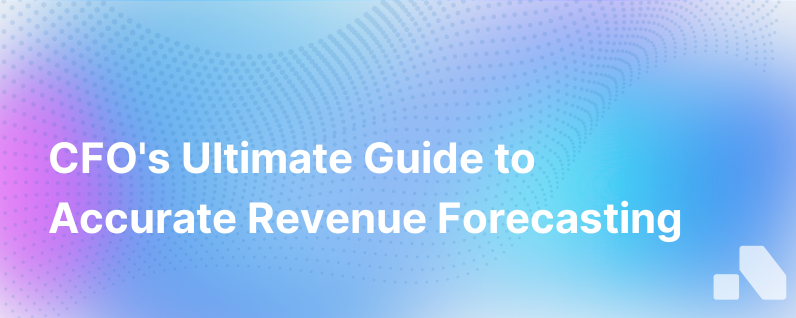
Revenue forecasting is the compass by which a company navigates its future. It's vital for strategic planning, cash flow management, and investment decisions. For the Chief Financial Officer (CFO), the task of revenue forecasting is not only a matter of number-crunching but also a balancing act between precision and adaptability. In this definitive guide, we shall delve into the art and science behind revenue forecasting and the strategies that CFOs can wield to forecast with more accuracy and impact.
Understanding the Importance of Accurate Revenue Forecasting
The CFO's role transcends mere financial management; it is crucial in shaping the company's growth trajectory. Revenue forecasting influences decisions on hiring, marketing spend, R&D investments, and operational scaling. Too optimistic a forecast might result in overextending resources, while too conservative an estimate may constrain growth potential. Accuracy in forecasting directly affects resource optimization and the ability to capitalize on market opportunities.
The Building Blocks of Effective Revenue Forecasting
Historical Data Analysis
Looking back is the first step to looking forward. Historical data provides a reality check, offering insights into seasonal trends, customer behavior patterns, and sales cycle length. This data becomes the foundation upon which predictive models are built.
Market Conditions and Industry Trends
External factors like economic conditions, market saturation, and competitive dynamics must be accounted for. These play roles in shaping demand, which, in turn, influences revenue potential.
Sales Pipeline Maturity
The state of the sales pipeline is indicative of near-term revenue. The CFO must work closely with the sales team to understand pipeline health, win rates, and sales velocity.
Pricing Strategy and Changes
Any adjustments to pricing strategies or the introduction of new products and services affect revenue. CFOs need to factor in how these strategic decisions may impact both existing customer base and potential new markets.
Customer Retention and Lifetime Value
Understanding client retention rates and customer lifetime value (CLV) is key in forecasting recurring revenue streams, especially for SaaS and subscription-based business models.
The Role of Predictive Analytics in Modern Revenue Forecasting
Predictive analytics has revolutionized traditional forecasting methods, leveraging vast amounts of data and machine learning algorithms to anticipate future revenue trends more accurately. This technology facilitates scenario planning and real-time adjustments to forecasts based on leading indicators and market shifts.
Leveraging Data to Inform Decisions
Amass and analyze data from a variety of sources – CRM systems, financial transactions, market research, and business intelligence tools. This data must be accurate, timely, and relevant.
Statistical Methods and Machine Learning
Utilize time series analysis, regression models, and machine learning to extract predictive insights from the data. These methods identify patterns and relationships that can inform more accurate forecasting.
Continuous Learning and Model Refinement
Predictive models are not set-and-forget tools. They require continuous training with new data to refine their accuracy. CFOs can ensure their forecasts remain relevant by adapting models to changing business conditions.
Implementing a Proactive Strategy for Revenue Forecasting
Scenario Planning
Rather than relying on a single forecast, CFOs should develop multiple scenarios to account for various potential outcomes. These scenarios should include best-case, worst-case, and most likely scenarios to encompass the full range of possibilities.
Regular Reassessment and Updates
Revenue forecasts are not static. They should be updated regularly to reflect new information, whether from internal performance metrics or external market developments.
Cross-Departmental Collaboration
Finance should not operate in isolation. Engage with sales, marketing, operations, and customer service to ground forecasts in operational realities and frontline insights.
Clear Communication of Forecast Assumptions
Transparency in how forecasts are derived is essential. All stakeholders need to understand the underlying assumptions so they can contribute to more accurate forecasting and align their expectations and plans accordingly.
Flexibility and Agility
Stay nimble. The CFO must create systems and cultures that can adjust quickly when actual results deviate from forecasts, whether that means capitalizing on an unexpected opportunity or mitigating a sudden downturn.
Best Practices for CFOs in Revenue Forecasting
-
Integrate Forecasts into Broader Financial Models: Revenue forecasts should not stand alone but be part of an integrated financial model that spans cash flow, budgeting, and expense management.
-
Invest in Forecasting Tools and Technologies: Consider technologies like AI-powered analytics platforms that enhance the speed and accuracy of forecasts.
-
Foster a Data-Driven Culture: Encourage all departments to harness data in decision-making processes and emphasize the importance of data quality.
-
Prepare for Global Economic Factors: In an increasingly globalized economy, be aware of international trends and risks that can affect revenue.
-
Educate Company Leadership on Forecast Complexities: Work with the executive team to understand the complexities and uncertainties inherent in revenue forecasting.
The Future of Revenue Forecasting
The future of revenue forecasting is increasingly becoming real-time and interactive, with cloud-based platforms and advanced analytics driving the charge. CFOs must be adept at using cutting-edge tools and methodologies while maintaining the strategic vision to guide their companies through an uncertain future.
With precision predictive analytics and a proactive strategic approach, CFOs can provide their companies with a competitive edge. Accurate revenue forecasting allows for confident decision-making and robust financial health, ultimately positioning a business for sustainable growth and success.
If this process sounds daunting, know that tools like Aomni are designed to aid CFOs by streamlining the collection and analysis of forecasting data, delivering insights that inform more precise revenue predictions with significantly less manual effort.